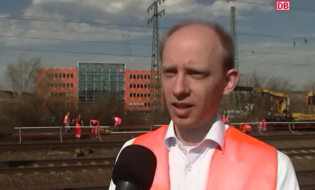When I talk to the team today, they usually say: It works, it's relatively simple, I would never have thought so, why didn't we do this before?
Philip Glanz, Senior Area Manager, Deutsche Bahn
Click on the play icon (on the left) to watch the full interview or the general Deutsche Bahn Practice video.
Interview with Philip Glanz.
My name is Philip Glanz and I'm the
Senior Area Manager for track maintenance here in the PD Hamm. In the track area, we are
responsible for repair and maintenance of the rail systems. We inspect them and replace
major components of rail points.
Why did you choose RSS?
For us there were several reasons. Firstly
the cost-effectiveness next to safety. The RSS system may not be the cheapest one on the
market, but we save approx. EUR 1000 per shift every time we use it. It is a safe
alternative opposed to automatic warning systems that do not prevent employees from
walking onto the neighbouring track, and exactly that is made possible by the fixed
barriers.
What do the savings consist of?
We bought these
fixed barriers as DB and they now belong to the depot. When we carry out normal safety
procedures we have a service provider who takes over the safety installations for us. We
are now saving those costs.
About the RSS system?
The RSS
system is a fixed barrier attached to the rail with a magnet. So when compared with
conventional fixed barriers, I no longer need to clear the area in which I am installing
the fixed barrier from ballast and attach the fixed barrier to the rail. It's much
faster, is more simple and I can do it from outside the rail area. That was impossible
up to now.
How long does it take to build the system?
Once
the employees have got the hang of it we can manage about 10 metres per minute. So I can
build a fixed barrier like the one you see behind me in 5 to 10 minutes. That has been
impossible up to now.
Licensing of the RSS system.
It is
often the case, of course, that we are wary of anything new. The biggest risk, or the
biggest question raised is: Can a magnet actually hold? Does the system work? Will it
not be torn off? What will happen if I lean against it? Is the system stable?
RSS
provided us with 30 metres for 2 months so we could test it here last year . We tested
it extensively with the team; the employees could try it out themselves right here. At
the end of the day we realised that the more of the system we build, and the longer it
is, the more stable it becomes. To that extent, all the questions or concerns we had
raised were actually history.
The experience of employees with
RSS
When I talk to the team today, they usually say: It works, it's
relatively simple, I would never have thought so, why didn't we do this before?
Why did you not choose RSS before?
There was no comparable system
before.



